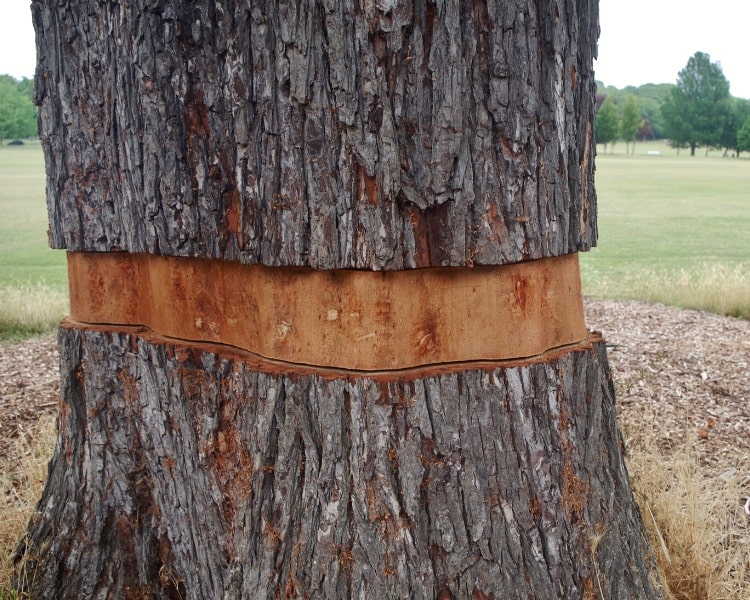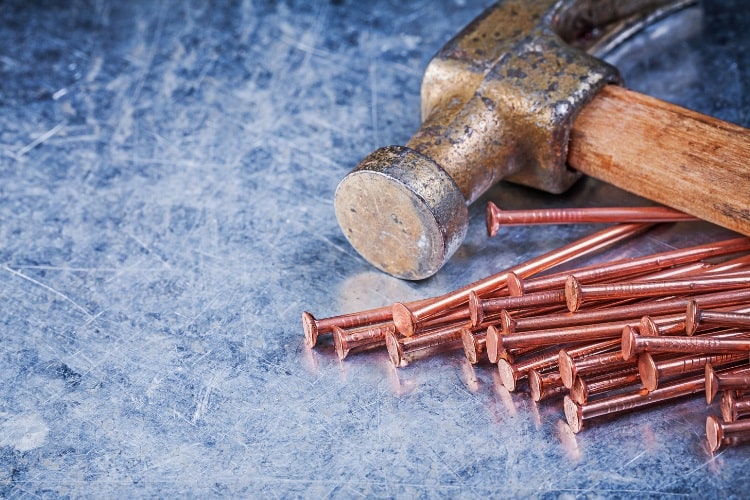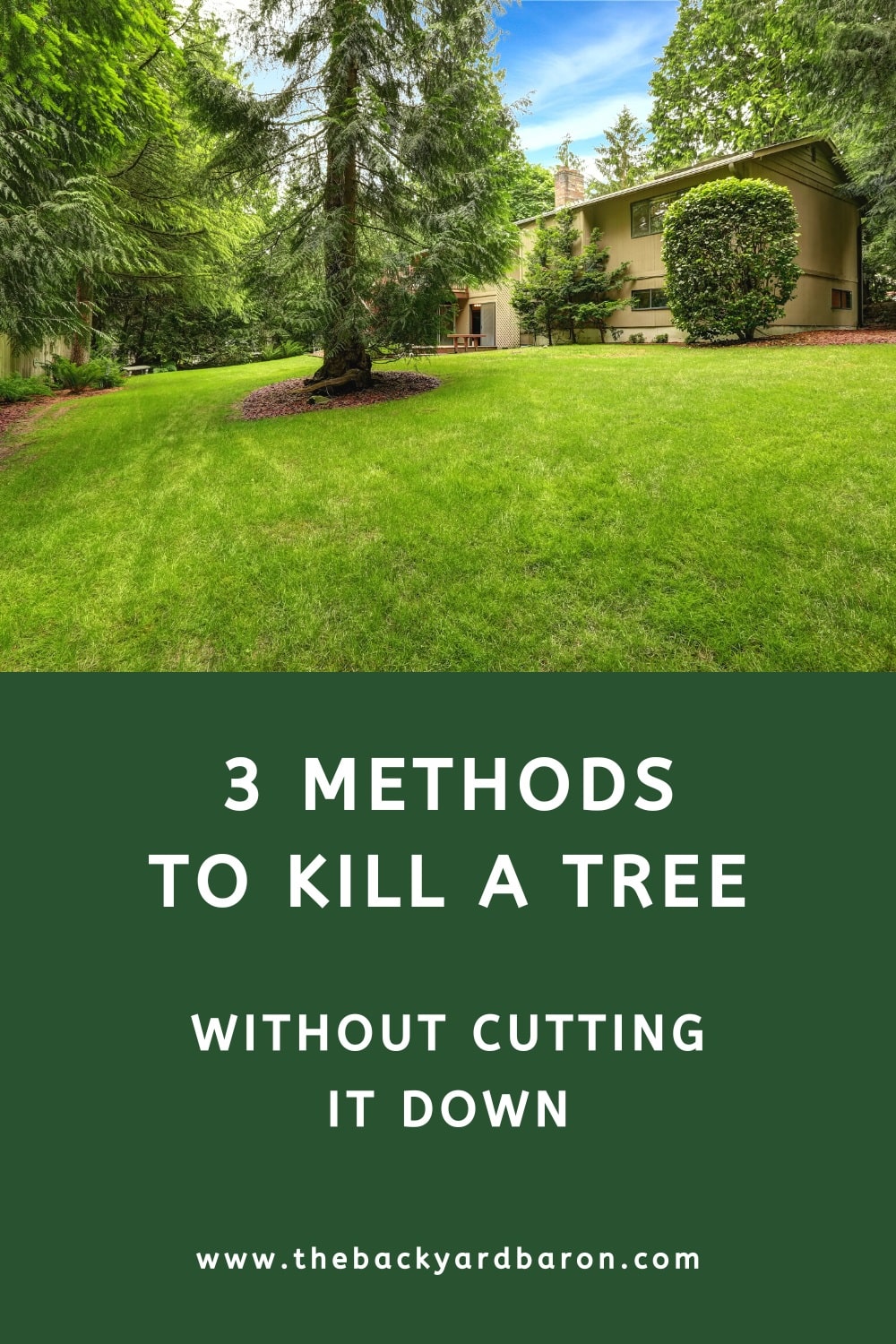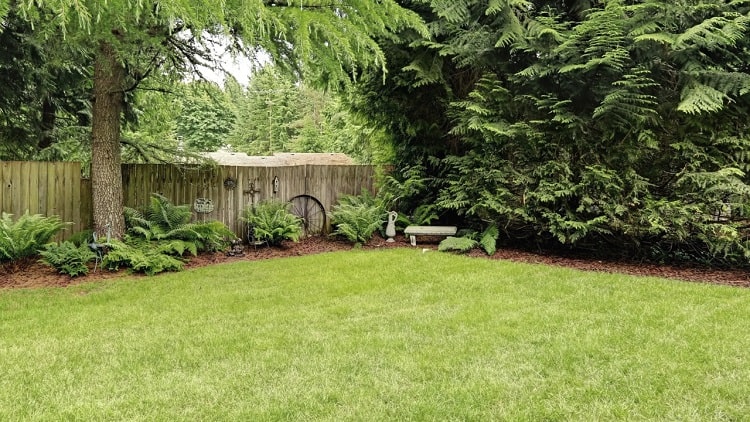Last updated: September 15, 2023
A guide explaining three methods to kill a tree without cutting it down. Learn more about girdling, using chemicals, and using copper nails.
While trees can be a beautiful addition to your yard, there comes a time when the tree has outstayed its welcome. Whether it’s growing past the point of unruliness or uncomfortably close to your home or driveway, there are reasons why you may need to get rid of a tree.
Cutting down a tree can be a difficult task, not to mention dangerous, especially with larger trees. If you’re hesitant to cut down a tree or don’t want anyone to know about your plans, you may want to consider more subtle methods of killing a tree without having to cut it down.
In this article, I am going to break down three of these methods.
Quick navigation:
3 Methods to Kill a Tree (Without Cutting)
The three easiest (but certainly not the quickest) ways to kill a tree without cutting it down are:
- Girdling the tree
- Using chemicals
- Using copper nails
Let’s discuss these three methods in more detail.
1. Girdle the Tree
Girdling a tree is the most common way to kill it without cutting it down. The girdling method involves cutting a notch or groove around the tree’s trunk. The incision will cut off the flow of sap between the roots and the rest of the tree, effectively cutting off the tree’s nutrient supply.
How to Girdle a Tree
To create that groove, you can use an axe, hatchet, or chainsaw. If you’re looking to eliminate multiple trees, a chainsaw would be best for this job. The groove placement is not too important, so choose a comfortable level to work at if you are using manual tools.
The notch must go all the way around the tree’s circumference. The incision should be about 1-1.5 inches in depth, depending on the size of the tree. A thicker tree will need a deeper cut, while a smaller tree will only need a shallow amount.
One notch should be enough, but you can add a second notch a few inches above the first for a larger tree to be on the safe side.

What are some pros and cons of using the girdling method?
Pros
Girdling a tree is a relatively simple alternative to cutting a tree. All you have to do is make your incision and wait for nature to take its toll on the tree. This is also an excellent method if you are looking to avoid using harmful chemicals.
Cons
Girdling a tree is a slow process; it can take months for the tree to die after being girdled. It is also not the best option for heartier trees that are notoriously hard to kill. You may need herbicides to speed up the process or assist with the more difficult tree species.
2. Use Chemicals
Herbicides are the obvious choice when it comes to killing your trees. A herbicide acts as a poison that will work its way into the tree and kill it.
How to Kill a Tree Using Chemicals
There are many factors to consider when using herbicides to kill a tree. First is the type of herbicide you will be using. Growth regulator type herbicides, such as triclopyr, are used to control plants’ growth, killing trees if used in excess.
Glyphosate and imazapyr are both herbicides designed to interfere with the synthesis of proteins in the tree, effectively killing the tree. The chemicals you choose ultimately depend on personal preference and the tree species you will use them on.
Once you’ve decided which chemicals to use, you will have to decide on the best method to use the herbicides:
- The hack and squirt method:
Make incisions into the bark and spray your herbicide into the cuts. You can create as many incisions as you like, and unlike with girdling, they do not need to encircle the tree completely. The goal is to poison the tree, not cut off the flow of nutrients. - Foliar herbicide:
Spray a growth control herbicide onto the leaves of the tree. This method is best for getting rid of young saplings, as fully matured trees will need a more potent herbicide. - Basal bark application:
Spray the tree’s bark using a soluble oil herbicide, such as triclopyr ester. The oil solubility of the herbicide will allow the chemical to penetrate the tree, poisoning it from the inside. This method is most effective on smaller trees (approximately 4 inches in diameter on average) or trees with thin bark.
What are some pros and cons of using chemicals to kill a tree?
Pros
Using a herbicide is the fastest and easiest method to kill your trees without having to cut them down. Chemicals will be quickly absorbed and spread throughout the tree.
Cons
While the quickest method, using hazardous chemicals is also the most dangerous method to kill trees. Proper safety precautions must be used to ensure that you are not putting yourself and others at risk. Always wear protective equipment to avoid getting any chemicals on your skin, and contact poison control if any herbicide has entered your system.
If your trees are near a water source, you must be extra mindful not to contaminate the water supply. Not only will contaminating the water impact other wildlife and foliage in the area, but it can contaminate our drinking water.
Herbicides are designed to kill all plants, so using them can hurt the other plants in your yard if you are not careful. Make sure the herbicide usage is directed solely at the trees you are trying to get rid of to avoid harming the grass and other plants you plan on keeping around.
Herbicides need to be adequately diluted to be safe to use. If the chemicals you’ve purchased are not prediluted, make sure you correctly follow the dilution instructions.
If you are uncomfortable working with dangerous chemicals, you would be better off hiring a professional. While this may be the more expensive option, it is ultimately the safer and wiser course of action.
3. Use Copper Nails
Copper nails are a simple household tool that can be used to kill trees.
The copper in the nail will be absorbed into the tree, where it will be passed through the different areas of the tree alongside the nutrients that are sustaining its life. Effectively poisoning it the same way a herbicide would without exposing you to toxic chemicals.
How to Kill a Tree With Copper Nails
Before you start, you will need to make sure the nails you are using are made of pure copper and not a copper compound. Next, you will need to hammer the nails into the roots or at the base of the trunk—whichever part is most accessible to you.
Having the pins as close to the root as possible is essential, as this will ensure that the copper is absorbed into the nutrients as early as possible.

What are some pros and cons of using copper nails?
Pros
Using copper nails is an easy, passive way to kill your trees without cutting them down. Hammering nails into the trunk of your tree requires less physical exertion than girdling and doesn’t expose you to harmful chemicals.
Cons
Using copper nails on your trees requires an understanding of your trees that the average gardener may not have. As mentioned above, nail placement is crucial. If the nail is placed too high up the trunk, it will not absorb enough copper to impact the tree. The depth of the nail inside the tree will also affect the amount of copper absorption inside the tree.
Small amounts of copper are beneficial for many trees. Traces of copper are often naturally found in soil, where it is naturally absorbed into the tree.
If the tree is not getting copper out of the earth, using copper nails may have the opposite effect, so the tree will get the nutrients it needs to live. Understanding the trees you’re working with and the soil they are growing in is integral to your decision-making process.
Final Thoughts
If you need to get rid of a tree but are hesitant to cut it down, there are several options available to you.
Girdling or hammering copper nails into a tree are easy fixes but take a while and are not guaranteed to work on their own. Using herbicides is a quicker but more dangerous way to kill trees because chemicals are involved.
Whatever method you choose, it is essential to do your research on the trees you’re looking to eliminate, as there is no one-size-fits-all solution. Some trees need a more aggressive approach, while others are easier to eliminate.


Would copper nails be effective to kill 1 of my oak trees? I can’t afford $1,750 to have it cut down. It ruined my house foundation, patio, roof.
Hi Diane, it might be worth trying, but honestly, the copper nail method is going to take a very long time with no guarantees it will work. Also, the bigger and healthier the tree, the less likely this method will work for you.
Sometimes getting the professionals in is the best choice, but yeah, it’s very expensive.
Thanx for this info. I have 2 trees within 12 inches of my porch eave, and right on my fence line. Both are about 24 to 36 inches in circumference, about 40ft tall.
My neighbor hates the trees too, because of limbs and leaves in his yard.
But the cost to have the trees removed is around $1,200 which I simply can’t afford, so I decided to just kill them. Hoping the poisoning option works!
Good luck Cheryl, hope it works out. Professional tree removal can indeed be very expensive.